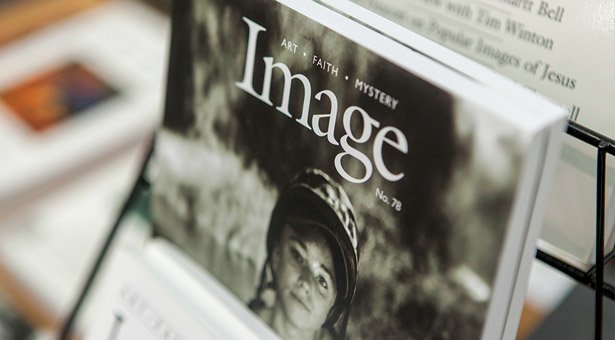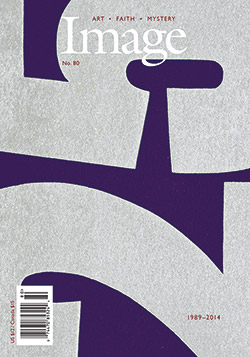Arts & Culture Faithful Creativity
Beauty Illuminated
Housed at SPU, Image Journal Celebrates 25 Years of “Art, Faith, and Mystery”
By Jeffrey Overstreet (jeffreyo@spu.edu) | Photos by Luke Rutan
 Image unveiled its new cover design in 2013. Recent featured artists include Anselm Kiefer, Kim Alexander, and Fritz Liedtke (pictured).
“People who read Image really need Image to exist,” says program director Tyler McCabe ’11.
Image unveiled its new cover design in 2013. Recent featured artists include Anselm Kiefer, Kim Alexander, and Fritz Liedtke (pictured).
“People who read Image really need Image to exist,” says program director Tyler McCabe ’11.
![]() View more photos
View more photos

As a Seattle Pacific University English major, Julie Mullins ’04 wanted to write artfully about faith. She’d seen a lot of mediocrity and sentimentality in “Christian art.” Valuing excellence, she sought “a vocabulary” that could bring art, faith, and justice together in a way that was “gritty, real, and profound.”
In 2002, she found it. She discovered Image, a literary arts journal based at SPU, and she took a “Contemporary Fiction” class from Gregory Wolfe — SPU’s writer-in-residence, and the founder and publisher of Image. Wolfe’s vision, says Mullins, “is what I had been looking for — a breath of fresh air.”
She became one of the first of many SPU English majors who have worked as Image interns, and Wolfe hired her as Image’s program director from 2005 to 2009.
Image has inspired conflicting responses since its first issue in 1989, says Managing Editor Mary Kenagy Mitchell: “Some pick up the journal and say ‘Religion? How interesting!’ Others jump back and say, ‘Religion? Oh, no!’’”
In the journal’s early days, Wolfe says he contended with two kinds of bias. Many in the art world viewed religious art as naïve, characterized by platitudes and wishful thinking. Others saw it as hostile and exclusive, dividing the world into “us” versus “them.” He meant for the journal to highlight beautiful, reconciling artwork crafted at the intersection of faith and art.
“We had a deep intuition that this was a human need,” he says. “Our little lamp illuminated only a small area, so there was a fear that we would put out three or four issues and then run out of material. But sometimes, when you seek you find.”
They found — and published — work by world-renowned artists and writers such as John Updike, Madeleine L'Engle, Oscar Hijuelos, John Irving, Mary Oliver, and Makoto Fujimura.
Others, including Annie Dillard, Kathleen Norris, Wim Wenders, Barry Moser, Richard Rodriguez, and Denise Levertov, have served on Image’s editorial advisory board.
Offering poetry, prose, and visual art shaped by Judeo- Christian faith traditions, the publication has survived more than the usual storms common to print journals in a world of digital media, short attention spans, and “culture wars.” And its influence now reaches into communities of writers, editors, and artists throughout academia.
“Image was a pioneer, explicitly connecting faith and art,” says Thom Caraway, editor of Whitworth University’s literary journal Rock and Sling. “It helps expand a Christian audience’s understanding of how literature can engage faith issues. It also expands the secular audience’s awareness of what Christian writing can do.”
Recognizing a strong spiritual and academic kinship, Seattle Pacific invited Wolfe and his wife Suzanne, a novelist, to join the English Department, and provided “an open space” for Image on campus in 2000. That partnership is flourishing. “Image really puts the SPU English Department on the national map,” says department chair Mark Walhout.
“Through my experience of writing in the Image community,” says Mullins, “I began to come to a fuller understanding of who God is, and how he knits us back together in our wounded places is coming forth.”
“There is a paradox here,” says SPU Professor of English Doug Thorpe. “Having a firm foundation in faith doesn’t mean that we don’t experience doubt, that we don’t go through dark nights of the soul. It’s inevitable that it will happen for the best of SPU’s students because they are thoughtful people. Image allows us to be challenged precisely because it is rooted in a foundation of faith.”
As Image’s program director, Mullins managed the Glen Workshops: weeklong, annual events in New Mexico and Massachusetts that give artists — beginners and professionals alike — opportunities to grow under the guidance of masters in poetry, fiction, songwriting, drawing, and many other art forms. The Glen, like the rest of Image’s event traditions, expands the community of artists and art lovers exploring the intersection of art and faith.
Author and pastor Debbie Blue, a former Glen Workshop chaplain and instructor, says she finds that “Image helps people who don’t consider themselves artists to believe creatively, to walk around the edges of the mystery, and to be attentive to beauty. All of those things are essential to the church.”
Writers are also learning in SPU’s low-residency MFA in creative writing program, cultivated by the Image team since 2005. It’s the only such program where faith is an explicit focus of the curriculum.
“There are certain people I send SPU’s way, because of the spirit of the MFA program,” says Stanley Rudin, director of Pacific Lutheran University’s MFA program.
Other Image/SPU collaborations include the Milton Fellowship, which gives an up-andcoming writer an opportunity to teach creative writing and present original work at SPU; the Fan Mayhall Gates Literary Reading Series on campus; and the Denise Levertov Award, presented annually to an influential artist engaging the Judeo- Christian tradition.
The title of Wolfe’s latest book, Beauty Will Save the World, comes from Dostoyevsky, and it echoes Wolfe’s vision for Image: As our culture clashes over what is right and true, beauty, says Wolfe, “has the ability to take us outside of ourselves into awe and wonder, which is what we were set down here in the first place to experience.”
On November 8, 2014, beauty resounded within Seattle’s St. James Cathedral. Four choirs and ensembles performed ancient and modern choral works (including three commissioned world premieres), combined with poetry readings, manifesting Image’s vision in celebration of its 25th anniversary.
That vision is also fulfilled on the last night of any Glen Workshop. At the close of the final worship service, artists and art lovers alike come forward in lines to receive a prayer of blessing for their life and work before they leave that intense immersion in fellowship and encouragement to carry inspiration into their daily routines.
“It’s a joyful thing to be anointed as artists,” says Mullins. “It’s like feeling the hand of God coming toward you and hearing ‘This is what I have made you to do. I honor what I created in you.’”
